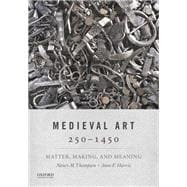Medieval Art 250-1450: Matter, Making, and Meaning is an innovative textbook for the undergraduate medieval art course. Using a case-study approach, the textbook engages students in close readings of medieval objects and buildings in their devotional and experiential contexts. It asks students to consider the fascinating trajectories of medieval images and objects, from invention to production and from reception to preservation.
Building on the art historical traditions of iconography and social history, Medieval Art 250-1450 uses the critical methodologies of gender, race, class, queer theory, post-colonialism, narrative, embodiment, materiality, and eco-criticism to inform its case studies. These modes of analysis encourage debate and often demonstrate to students that ideas pertinent to contemporary issues are at stake in the study of medieval art. These critical methods support the image analyses in the text and intersect with the art historical content.








